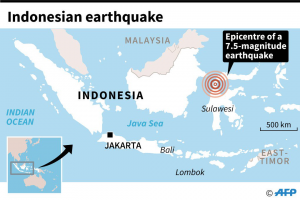Indonesia: Tsunami early detection buoys haven’t worked for six years
Indonesia’s disaster agency says early detection tsunami buoys off the coast of Sulawesi have not been working for six years “due to lack of funding”, resulting in insufficient warning before rising waters reached the shore.
Published 6 years ago, updated 5 years ago
Big waves as high as six metres following the magnitude-7.5 earthquake on Friday killed at least 832 people in the cities of Palu and Donggala — highlighting the weaknesses of the existing warning system and low public awareness about how to respond to warnings.
A network of 22 buoys connected to seafloor sensors was meant to transmit advance tsunami warnings to the Indonesian meteorology and geophysics agency (BMKG).
But Sutopo Purwo Nugroho, spokesman for the National Disaster Mitigation Agency (BNPB), said the detection buoys had not worked since 2012 due to a lack of funding.
The buoys, designed to detect tidal waves and potential tsunamis, are the fastest early detection tsunami technology in the country.
Mr Nugroho said BMKG, which was responsible for alerting residents to potential tsunamis, also had not effectively reached many of the people who were affected.
Early warning could have provided critical information
Indonesia’s geophysics agency issued a warning for a tsunami of up to 3 metres following the magnitude-7.5 earthquake at about 6:00 pm on Friday (local time), but lifted the warning 34 minutes after it was first issued.
BMKG defended the decision based on a recording of an “insignificant” 6-metre wave 300 kilometres south of Palu, which did not account for the giant waves near the shore.
Louise Comfort, an expert in disaster management at the University of Pittsburgh, said the early warning system had been stalled in the testing phase for years.
“In the Sulawesi incident, BMKG … cancelled the tsunami warning too soon, because it did not have data from Palu. This is the data the tsunami detection system could [have provided],” Professor Comfort said.
A concerted international effort was launched to improve tsunami warning capabilities after the 2004 tsunami killed 230,000 people in a dozen countries — more than half of them in the Indonesian province of Aceh.
The efforts particularly targeted the Indian Ocean and Indonesia, one of the world’s most earthquake and tsunami-prone countries.
The high-tech system of seafloor sensors, data-laden sound waves and fibre-optic cable was meant to replace a system set up after the 2004 earthquake and tsunami killed nearly 150,000 people in Aceh.
However, internal politics and delays in getting 1 billion rupiahs ($92,867) to complete the project meant the system hasn’t progressed beyond a prototype.
Read the rest of this article at http://www.abc.net.au
Related to following destinations: Indonesia, North / Central Indonesia - Sulawesi
Related to the following Cruising Resources: Earthquakes and Tsunamis, Weather






